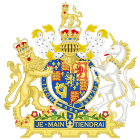| Moss Troopers Act 1662 | |
|---|---|
| Act of Parliament | |
 | |
| Long title | An Act for preventing of Theft and Rapine upon the Northern Borders of England |
| Citation | 14 Cha. 2. c. 22
|
| Dates | |
| Royal assent | 19 May 1662 |
| Commencement | 29 September 1662 |
| Expired | 28 September 1667 |
| Repealed | 28 July 1863 |
| Other legislation | |
| Amended by | Moss Troopers Act 1666 |
| Repealed by | Statute Law Revision Act 1863 |
Status: Repealed | |
| Text of statute as originally enacted | |
| Moss Troopers Act 1666 | |
|---|---|
| Act of Parliament | |
 | |
| Long title | An Act to continue a former Act for preventing of Thefte and Rapine upon the Northerne Borders of England. |
| Citation | 18 & 19 Cha. 2. c. 3
|
| Dates | |
| Royal assent | 18 January 1667 |
| Commencement | 21 September 1666 |
| Expired | 28 September 1673 |
| Repealed | 28 July 1863 |
| Other legislation | |
| Amends | Moss Troopers Act 1662 |
| Repealed by | Statute Law Revision Act 1863 |
Status: Repealed | |
| Text of statute as originally enacted | |
| Moss Troopers Act 1677 | |
|---|---|
| Act of Parliament | |
 | |
| Long title | An Act for continuance of two former Acts for preventing of Theft and Rapine upon the Northerne Borders of England. |
| Citation | 29 & 30 Cha. 2. c 2 |
| Dates | |
| Royal assent | 20 March 1678 |
| Expired | 2 July 1687 |
| Repealed | 28 July 1863 |
| Other legislation | |
| Repealed by | Statute Law Revision Act 1863 |
Status: Repealed | |
| Text of statute as originally enacted | |
| Moss Troopers Act 1685 | |
|---|---|
| Act of Parliament | |
 | |
| Long title | An Act for Continuance of Three former Acts for Preventing of Theft and Rapine upon the Northerne Borders of England. |
| Citation | 1 Ja. 2. c. 14 |
| Dates | |
| Royal assent | 27 June 1685 |
| Repealed | 28 July 1863 |
| Other legislation | |
| Repealed by | Statute Law Revision Act 1863 |
Status: Repealed | |
| Text of statute as originally enacted | |
| Moss Troopers Act 1695 | |
|---|---|
| Act of Parliament | |
 | |
| Long title | An Act to continue Foure former Acts for preventing Theft and Rapine upon the Northerne Borders of England. |
| Citation | 7 & 8 Will. 3. c. 17 |
| Dates | |
| Royal assent | 10 April 1696 |
| Other legislation | |
| Repealed by | Statute Law Revision Act 1867 |
Status: Repealed | |
| Text of statute as originally enacted | |

Moss-troopers were brigands of the mid-17th century, who operated across the border country between Scotland and the northern English counties of Northumberland and Cumberland during the period of the English Commonwealth, until after the Restoration.
Much like the earlier Border reivers who had operated in the lawless region during the 16th century and were dealt with, [1] moss-troopers do not have a clear genesis. They gradually evolved, or reemerged, from the long running sociopolitical milieu of the Border. Mention of them appears suddenly in historical records and gives the false impression that they appeared suddenly, but the first statute passed to deal with them, the Moss Troopers Act 1662 (14 Cha. 2. c. 22), notes the moss-troopers to have been a long-running problem. [2]
With the 1662 act about to expire, the Cavalier Parliament passed the Moss Troopers Act 1666 (18 & 19 Cha. 2. c. 3). Under section two of this act, the benefit of clergy was taken away from those convicted, which generally meant a death sentence, or otherwise with judicial discretion, the notorious thieves and spoil-takers in Northumberland or Cumberland were to be transported to America, "there to remaine and not to returne". [3] [4]
Many moss-troopers were disbanded or deserting soldiers from one of the Scottish armies of the Wars of the Three Kingdoms. They had kept their weapons and lived a life of brigandage, attacking both civilians and Parliamentary soldiers for supplies during the Royalist rising of 1653 to 1654 when English Parliamentarian troops under George Monck occupied Scotland. Moss-troopers usually operated in small bands, either on the fringes of the Highlands or in the border regions. [5] Many Highland lairds complained of moss-troopers' cattle-stealing and of how they incurred military reprisals against the Highlands as a whole.
Some moss-troopers may[ original research? ] have had a national-political as well as an economic motivation, believing in resisting the Cromwellian occupation of Scotland – much as their Irish contemporaries, the "tories", in part resisted English occupation.











